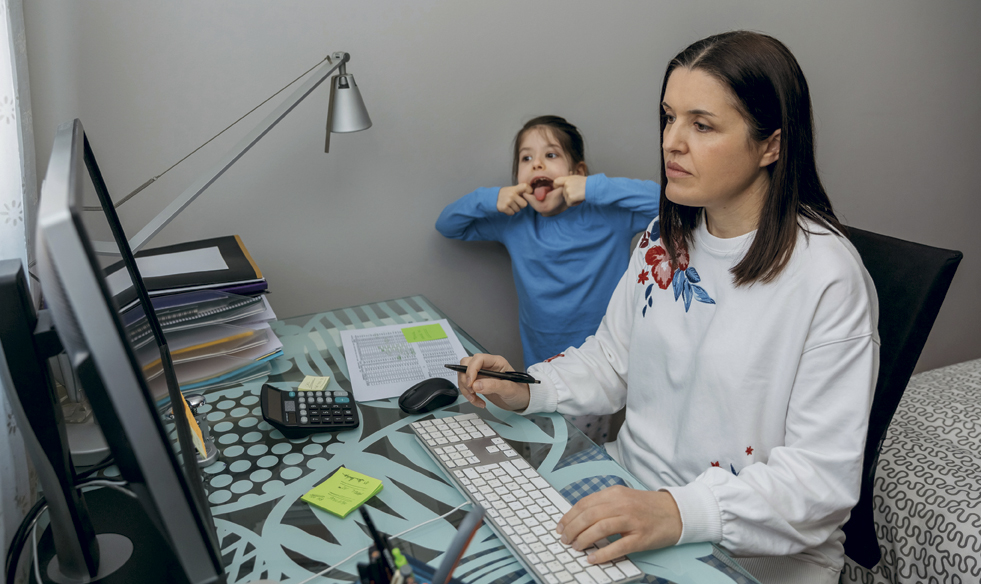Young Professionals
WORKING FROM HOME WITH KIDS: THE SEQUEL
Additional tips for a productive day while watching your youngsters
By Christopher W. Cook
The summer of 2020 will certainly be one to remember. As a frequent concertgoer, I added numerous live-concert DVDs to my video collection to temporarily substitute the real thing.
Following the shelter-in-place orders passed earlier this year, the next steps toward reopening the economy differ across the country depending on where you live. As this month’s issue is released, my home state of Indiana should be back to “business as usual” with recommended safety measures like wearing masks and keeping a six-foot distance from one another. And while it’s probably a 50/50 crapshoot of my state’s residents following these suggestions, I’ll continue to avoid public places and events if possible.
But one thing that can’t be avoided is our kids returning to school. As the fall semester approaches, will schools be considered safe and allow children to attend in-person classes? Numerous parents became teachers during the spring semester’s stay-at-home orders, while balancing their own workloads in the process. Will this continue longer?
What to do?
Let’s look at some additional advice on how to manage working from home with your children present:
Continuing education. Even though it’s been “summer vacation” for the past few months, it never hurts to continue learning, and that’s a lesson for all of us.
Sarah Conway, executive director for the Insurance Industry Charitable Foundation’s (IICF) Southeast Division, is expecting her third child soon, while working full-time from home with her two boys, ages four and two. She has kept education a key focus during the summer months.
“We continue to incorporate one to two hours of ‘school time’ each day with age-appropriate workbooks,” she says. “We’ve enjoyed introducing IICF’s Every Day is a Reading and Writing Day into our routine. This program, developed in partnership with Sesame Workshop, is a research-based, free, bilingual resource, offering educational games, videos and activities. My sons love seeing Cookie Monster and Elmo while learning.
“IICF has redistributed these materials during the pandemic to the insurance industry and to nonprofits working with children and their families. It has been helpful with visual components and repetition and has assisted in reinforcing my sons’ knowledge of colors, numbers and letters,” she continues. “As a parent, the tool has been helpful offering ideas to prompt conversations that facilitate learning. For example, we’ve been pointing out the letters on the stop signs during afternoon walks.”

—Dani Kimble
Chief Marketing Officer
O’Neill Insurance
Managing screen time. Portable video devices can be a blessing or a curse, but one thing this writer knows is that I’m glad I grew up in the era before them. Sure, I spent plenty of time in front of the TV, watching cartoons and The Price is Right while eating lunch, but I also enjoyed plenty of hours outside playing with the other boys in the neighborhood (fun fact: there’s still a “Caution, Kids At Play” sign in my mom’s neighborhood that went up during my childhood years).
Kids these days can keep themselves occupied on iPads, with all the free and/or paid streaming services for videos and music. But is there a limit? While limitations may be a standard in some households, the current situation of working with kids at home may alter the household rules. Conway and her husband have been a little more lenient on their kids’ electronics allowance.
An account manager at the Brownyard Group, Sandra Reitan uses timers for her six- and eight-year-old boys for various activities, including use of portable devices.
“My kids respond well to the timers and know it is time to switch activities once it goes off,” she says. “I set timers for things like video game time, tablet time and TV time, as well as reading time.”
“I have rules around limiting screen time, but when they are allowed to watch TV or be on an iPad, there are so many educational shows and apps to engage with,” adds Dani Kimble, chief marketing officer at O’Neill Insurance. “I don’t like resorting to the screen, but with balance, it’s a good go-to.”
Kimble is working full-time from home with her three kids, ages seven, five and three.
Socializing with friends and family. How has the coronavirus affected your children’s social activities this summer? Are your local youth sports organizations operating and is there a limitation to the number of people allowed at the community swimming pool, if it’s open at all?
Websites like Zoom, FaceTime and Facebook Messenger have been lifesavers during these times for keeping kids connected with their friends and family. While it seems that kids know more about this technology than their parents—even I ask my nephews questions about the more recent Xbox models—does this type of socializing interfere with your workday?
“With the support of my CEO allowing me to work ‘odd hours’ when needed, I’ve been able to connect my kids on Zoom playdates, some of which have taken place during traditional work hours,” says Conway. “We use FaceTime to talk regularly with grandparents and Zoom to see friends and classmates.”
Kimble’s children had multiple scheduled weekly Zoom calls with classmates during the closing months of the spring semester. “They did happen during work hours, and I made sure to not schedule anything around their Zoom meetings,” she says.
“For Zoom calls with family or Facetime chats with friends, we typically only do them after my working hours, and in-person family visits, while social distancing, are on weekends or after working hours,” adds Reitan. “The kids speak to some friends on Facebook Messenger Kids on their devices, and the app allows me to monitor their activity.”

—Sandra Reitan
Account Manager
Brownyard Group
“When I have a busy day, or a day filled with meetings, I create scavenger hunts for my kids,” says Kimble. “I have a checklist of about 15 different items they must find and check off their list.”
During the COVID-19 pandemic, some locations that normally would be prime for school field trips have offered virtual experiences online.
“My kids have been to zoos all over the country through their live virtual cameras,” says Kimble. “They have also been to museums, other countries, farms, and even outer space. They love virtual field trip days.”
And how about the old tradition of “bring your kid to work day”?
“As a marketer, my oldest loves watching me create graphics for our social media channels,” says Kimble. “Some days, she will sit next to me on her lap-top and try and create graphics herself. It’s an opportunity for me to show her the work that I do and teach her a new skill that she may be interested in learning more about as she gets older.”
“We switch up activities, which keeps my kids ‘busy’ for chunks of time, and this allows me to fully focus on my work,” adds Reitan. “My husband is very helpful on his days off with keeping the kids occupied.”
Reitan’s boys did their schoolwork in the morning and then switched to watching TV, playing on the tablet or video games, doing arts and crafts or puzzles, reading, or playing outside.
“I purposely set up my home office space in our dining room so I can see them when they are playing outside,” she says. “Luckily, my boys are close in age and play well together (for the most part). My older son does need some time without his little brother from time to time, and we make that happen when needed.”
“My older son can independently work on tasks, schoolwork and art projects, while the youngest may need to sit on my lap during a meeting,” says Conway. “I’ve also tasked our older son more with helping to entertain his little brother when we are in meetings by asking him to read a book or help him get a snack.
“To meet the constant demand for drinks and snacks, I set up snack baskets and cups, so they can help themselves to healthy snacks and not interrupt workflow as often,” she adds.
Final advice
The summer of 2020 may be looked back at as a trying one with new ups and downs and experiences. As an industry, and especially its members who are parents, we are all in this together. What final advice is there to share?
“Be honest and open with your co-workers and boss,” says Conway. “You will find tremendous support and positivity with open communication.
“Utilize the internet. There are many educational apps and programs you can use to your advantage. During this time, be more lenient with screen time. The kids will be okay.”
While the kids enjoy their content, be cautious if they are around when you are watching the local or national news.
“Protect your kids from seeing too much news,” Conway says. “I think it can add to stress and anxiety as they can’t comprehend everything they hear. Be sure to maintain open channels and look to your pediatrician or to reputable guidelines online for age-appropriate advice for talking to kids about difficult subject matter.”
Make sure to carve out time that’s strictly family time.
“At dinnertime, disconnect from work and enjoy a meal as a family,” Conway says. “With constant emails and phone calls, work and home time are coinciding, and we need to set boundaries.”
“Parents who work full time always feel the struggle of balancing home and work life, and this situation has made it more challenging because work is now inside our homes,” adds Kimble. “Give yourself grace; parenting is hard. We leave a meeting and suddenly we are in our kitchen making peanut butter and jelly sandwiches for our kids. In moments when you may be having a rough day at work, and your emotion carries into your home life, it’s difficult to separate the two.
“I think it’s easy for parents to get overwhelmed with the situation we’re in and focus more on the stressors and less on all the positives that can come from this.”
Kimble started a gratitude journal to help with this.
“Each morning, I write down five things I am grateful for, and 10 life dreams,” she says. “It helps kick off my day in the right direction. My children have been in daycare since they were two months old. For the first time ever, I get to be home and be present with them every day. I am way more in touch with their feelings and emotions and have found peace in focusing on all the good that can come from these moments.”
Reitan echoes the challenge of getting overwhelmed. “Don’t be so hard on yourself,” she says. “The balance can be challenging, and we have to forgive ourselves for the attention we may not be able to give our kids at times.
“They are seeing us in a whole new light as professionals, live and in person. I believe we are setting a great example to our kids of hard work and dedication and that’s something we should all feel good about,” she concludes.






